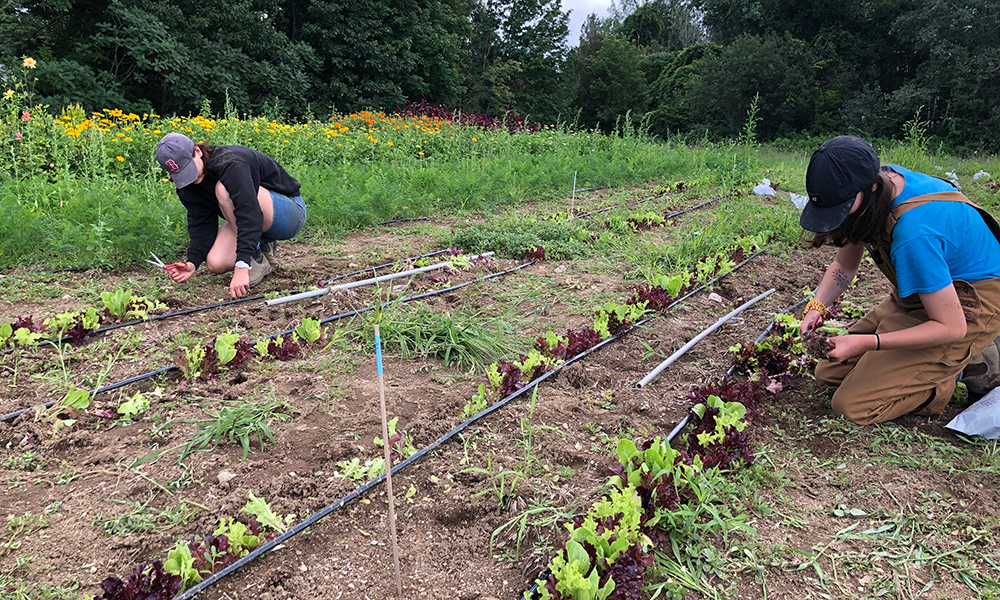Small-Scale Farmers Explore Ways to Sustainably Reduce Weed Growth: Tradeoffs of Tarping
Feb. 21st 2023With a growing community of small, organic farms emerging in and around Vermont, the study and application of agroecology—applying ecological principles and a social justice lens to farming—has gained popularity. Farmers are exploring and adopting agroecological practices such as rainwater harvesting, cover cropping, organic fertilizer use, and crop diversification. Tarping is another potential agroecological practice that is exactly what it sounds like, putting a plastic tarp over a field for a few weeks before planting crops, meant to reduce weed growth without the use of herbicides.
While farmers in Vermont and beyond are interested in incorporating agroecological practices on their farms, for many of these practices, including tarping, farmers do not have sufficient data available to understand their impacts. In a study led by Dr. Eva Kinnebrew, a recent UVM PhD graduate, researchers measured impacts of tarping on three Vermont farms. The research team collected quantitative data on the impacts tarping has on crop yields, arthropod diversity, soil temperatures, nutrient levels, and weed abundance. Additionally, they interviewed four farmers twice throughout the study to learn about their experiences with tarping and how the field study data changed or confirmed their perceptions of tarping.
“Farmers are well aware of many of the tradeoffs of tarps – for example, they can clearly see the benefit tarps have on reducing weeds,” said Kinnebrew. “However, there are some variables that are harder to understand, like impacts on soil nutrients and biodiversity. That’s where academic researchers can come in and provide insights. It’s important to get a full understanding of tarps’ effects because we want to make sure tarps don’t have unintended ecological consequences.”
The field study was set on three small-scale certified organic vegetable farms in Chittenden County. On each farm, the researchers tested two different types of tarps: black silage tarps and clear plastic tarps, in addition to a control plot with no tarp. The field study collected data about the biological and physical impacts of tarping.
The researchers supplemented this data with eight interviews—two with each of four farmers—to determine the socio-economic impacts of tarping and to share the field results. The continuous relationships with farmers were central to this research and instrumental in the designing, planning, and data analysis stages of the study.
“We conducted this study using Participatory Action Research (PAR). In PAR, stakeholders – in this case farmers – help choose research questions, design methods, and interpret results,” explained Kinnebrew. “Co-creating knowledge in this study using PAR was extremely important to us because it helps make the research results more applicable and realistic to farmers.”
The results of the field study indicated that tarping is effective at suppressing weed growth. By five weeks after tarp removal, the control plots had an average of around 90 percent weed coverage while the tarped plots had around 30 percent weed coverage. However, certain weeds such as purslane were not as affected by the tarps due to their ability to grow in hot environments.
Tarping additionally increased soil temperatures and crop yields. The clear tarps yielded the highest temperatures with soil surface temperatures of up to 59 degrees Celsius compared to 52 degrees Celsius for the silage tarps and 43 degrees Celsius with no tarp. Tarps also doubled crop yields, which matched the anecdotal evidence gathered from the interviews with farmers who shared their observations of better-looking crops when they tarp. Tarping also had short-term negative impacts on aboveground and belowground arthropod diversity and had varying impacts on soil nutrients depending on the farm site.
Through the interviews, the study helped to gauge social and economic impacts of tarping with the main benefits being saving time and modeling a low-input practice—not having to apply harsh chemical fertilizers each year. The main challenge for farmers was the difficulty of putting on and removing tarps, which, because tarps are large and heavy, takes time and multiple people. Additionally, farmers must adjust their planting schedules for tarping to be successful, giving the tarp two to four weeks on the fields at the beginning of the season as opposed to an afternoon of tilling.
Overall, the study found that tarping does yield many ecological and socio-economic benefits for farms and farmers. Tarping successfully suppresses weed growth and increases crop yields without the ecological impacts of tilling or herbicide application. Conversely, tarping has unknown long-term effects on soil biodiversity and pest dynamics, and inconsistent impacts on nutrient availability.
“To better understand tarps’ impacts, we need studies that last multiple years, and which specifically compare tarping with other common weed suppression practices, like tilling,” said Kinnebrew. “One important take-away from this study was that while farmers value academic knowledge, they also heavily rely on their own observational knowledge and experiences. This emphasizes the value of PAR, because by co-creating knowledge with farmers and documenting and validating their knowledge of tarping, we hopefully make this research more credible to farmers.”
This project was funded by Northeast SARE, project code GNE19-205.
 ecoNEWS VT
ecoNEWS VT